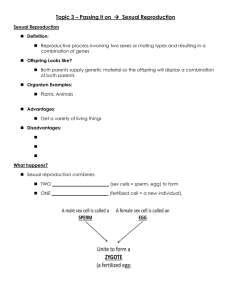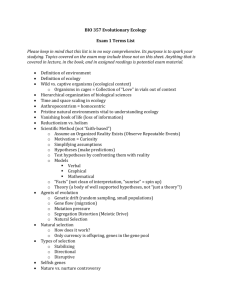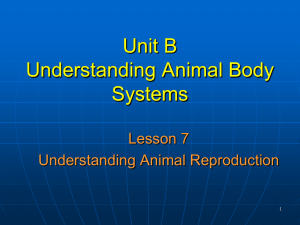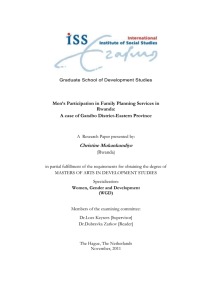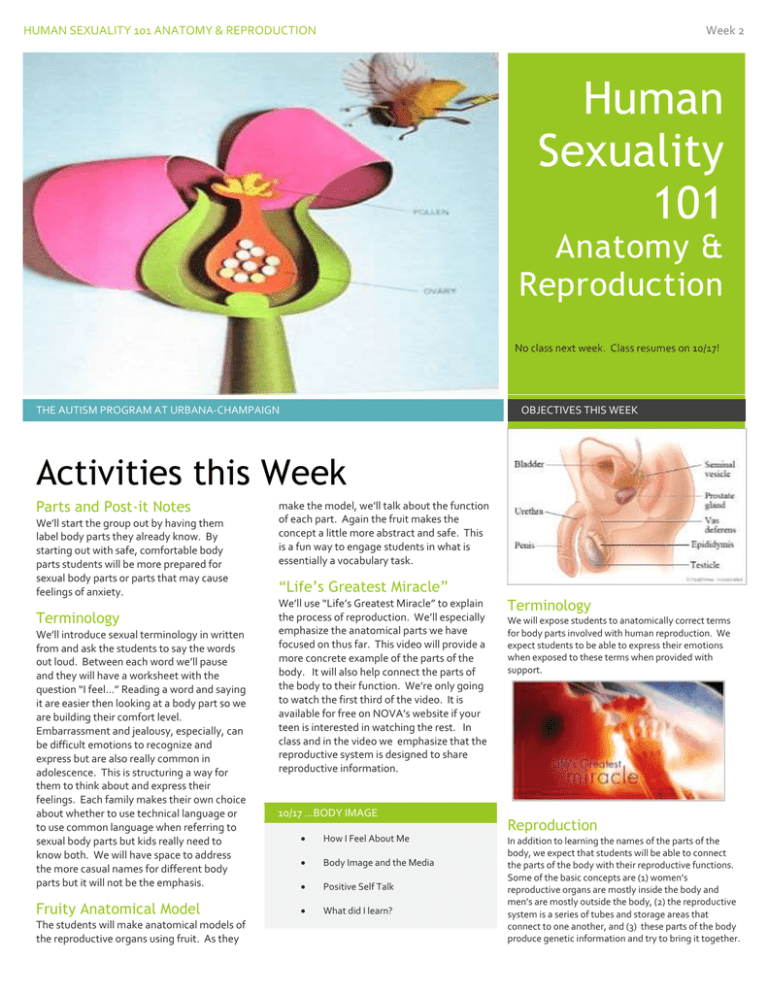
HUMAN SEXUALITY 101 ANATOMY & REPRODUCTION
Week 2
Human
Sexuality
101
Anatomy &
Reproduction
No class next week. Class resumes on 10/17!
THE AUTISM PROGRAM AT URBANA-CHAMPAIGN
OBJECTIVES THIS WEEK
Activities this Week
Parts and Post-it Notes
We’ll start the group out by having them
label body parts they already know. By
starting out with safe, comfortable body
parts students will be more prepared for
sexual body parts or parts that may cause
feelings of anxiety.
Terminology
We’ll introduce sexual terminology in written
from and ask the students to say the words
out loud. Between each word we’ll pause
and they will have a worksheet with the
question “I feel…” Reading a word and saying
it are easier then looking at a body part so we
are building their comfort level.
Embarrassment and jealousy, especially, can
be difficult emotions to recognize and
express but are also really common in
adolescence. This is structuring a way for
them to think about and express their
feelings. Each family makes their own choice
about whether to use technical language or
to use common language when referring to
sexual body parts but kids really need to
know both. We will have space to address
the more casual names for different body
parts but it will not be the emphasis.
Fruity Anatomical Model
The students will make anatomical models of
the reproductive organs using fruit. As they
make the model, we’ll talk about the function
of each part. Again the fruit makes the
concept a little more abstract and safe. This
is a fun way to engage students in what is
essentially a vocabulary task.
“Life’s Greatest Miracle”
We’ll use “Life’s Greatest Miracle” to explain
the process of reproduction. We’ll especially
emphasize the anatomical parts we have
focused on thus far. This video will provide a
more concrete example of the parts of the
body. It will also help connect the parts of
the body to their function. We’re only going
to watch the first third of the video. It is
available for free on NOVA’s website if your
teen is interested in watching the rest. In
class and in the video we emphasize that the
reproductive system is designed to share
reproductive information.
10/17 …BODY IMAGE
How I Feel About Me
Body Image and the Media
Positive Self Talk
What did I learn?
Terminology
We will expose students to anatomically correct terms
for body parts involved with human reproduction. We
expect students to be able to express their emotions
when exposed to these terms when provided with
support.
Reproduction
In addition to learning the names of the parts of the
body, we expect that students will be able to connect
the parts of the body with their reproductive functions.
Some of the basic concepts are (1) women’s
reproductive organs are mostly inside the body and
men’s are mostly outside the body, (2) the reproductive
system is a series of tubes and storage areas that
connect to one another, and (3) these parts of the body
produce genetic information and try to bring it together.
HUMAN SEXUALITY 101 ANATOMY & REPRODUCTION | Week 2
2
Conversation Topics- Parenting
We didn’t talk specifically about parenting,
but it’s something that may be on the
horizon. Wanting to be a parent is a natural
urge that most people experience. These
urges can be difficult to manage especially if
the person needs some level of support to be
independent. Because someone has a
diagnosed disability, people often feel that
they have the right to question that person’s
ability to be a parent. What makes this
especially tricky is that in some cases those
concerns might be valid. You may be asking
yourself the question, “Will my son or
daughter be capable of having children one
day?” Many people with disabilities are
capable of being excellent parents. No
parents can raise children 100% on their own;
everyone needs help sometimes. On the
other hand it is easy to get wrapped up in the
joys of having a child without thinking of all
the sacrifices and responsibilities. What are
your hopes and fears about your child as a
possible parent? What do you need to do to
support your child with making the best
choice for them?
Conversation Topics- Birth Control
We did not talk specifically about birth
control and you may think that your child is
not sexually active so birth control is not
something that you have to worry about.
There are a few things to keep in mind.
1) You may not always know if your child is
sexually active or not. Ideally you and your
child would share similar values about the
timing of sexual activity and they would feel
comfortable coming to you. However, young
people sometimes go to great lengths to
hide their sexual activity from their parents.
How do you communicate your values about
sexual activity?
2) Although it’s not common, one of parents’
greatest fears is the possibility that their
child could be taken advantage of.
Furthermore, despite education they may
not fully grasp the implications of their
choices. How do you promote safety without
instilling fear and shame?
Additional Resources
A Birth Control Resource
Asdsexed.wordpress.com
TeachingSexualHealth.ca has a nice
webisode about how to address
contraception with your child (in addition to
other resources).
Individuals with Disabilities as
Parents
AutismNow.org has a lot of great resources
for families Autism including several
webinars about sexuality topics. They have
webinar presented by self-advocates about
being parents. Below is one of the slides
from the webinar.
There is also a documentary called Is Love
Enough? that you may find interesting. This
movie shares one couple’s story.
What Other Parents are Going
Through
AThinkingPersonsGuidetoAutism.blogspot.c
om is a blog by people with Autism, family
members, and professionals. Most of the
articles are not about sexuality but I find
those that are to be very insightful.









